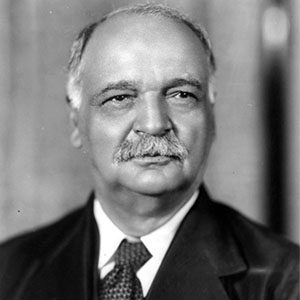Charles Curtis served as 31st Vice President of the United States, holding the office from 1929-1933 under President Herbert Hoover. Curtis was the first person with significant Native American ancestry to reach the White House.
Early Life
Charles Curtis was born in Topeka, Kansas, on January 25, 1860. His mother was one-quarter Kansa Indian, and Curtis spent some of his childhood years living with the Kaw Indian tribe. After attending school in Topeka, Curtis studied law and was admitted to the Kansas bar in 1881. He subsequently launched his own criminal law firm. In 1884, Curtis married Anna Baird. They had three children and also assumed custody of Curtis’ half-sister Dolly when her mother died.
Political Career
Curtis entered politics as county attorney of Shawnee county, holding the position from 1884 to 1888. He was elected to the United States House of Representatives in 1893 and won reelection for the next six terms. While serving in the House, Curtis played a key role in the passage of the “Act for the Protection of the People of Indian Territory,” which became known as the Curtis Act. It amended the Dawes Act to abolish the tribal governments of the Five Civilized Tribes of Indian Territory and provided for allotment of communal land to individual tribal members. While Curtis believed that education and assimilation was in the best interests of Native Americans, he later wrote that the final bill did not reflect his intentions.
In 1907, Curtis was elected by the Kansas Legislature to the U.S. Senate seat vacated by Joseph R. Burton. Curtis was reelected and served until March 4, 1913. In 1912, Democrats took over the Kansas legislature, thwarting Curtis’ bid for reelection. Following the 1913 enactment of the 17th Amendment, which established the direct election of U.S. Senators, Curtis won back a Kansas Senate seat via the popular vote. He went on to serve from March 4, 1915 to March 3, 1929.
Curtis served as Senate Minority Whip from 1915 to 1925 and then as Senate Majority Leader from 1925 to 1929. While Curtis was a “stand patter” that could be counted on by the Republican party, he was also known for being able to successfully negotiate with the party’s progressives and his Democratic colleagues.
Vice Presidency
Curtis opposed Herbert Hoover for the Republic nomination for President in 1928. However, he came in second and was subsequently nominated to run for Vice President alongside Hoover. They won by a landslide, with an electoral vote tally of 444 to 87.
Once in office, the former rivals failed to develop a close relationship. Although Curtis was invited to attend some cabinet meetings, he played a limited role in the Hoover Administration. His chief responsibility was to preside over the Senate, where he cast a few tie-breaking votes. Compared to his prior political positions, Curtis found the Vice Presidency to be unfulfilling.
Hoover and Curtis lost their reelection bid 1932, largely due to the Administration’s failure to lead the country out of the Great Depression. They lost by a wide margin to the Democratic ticket of Franklin D. Roosevelt and John Nance Garner. After leaving office, Curtis resumed the practice of law in Washington, D.C. He died on February 8, 1936 of a heart attack.









